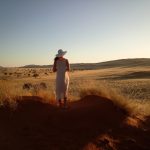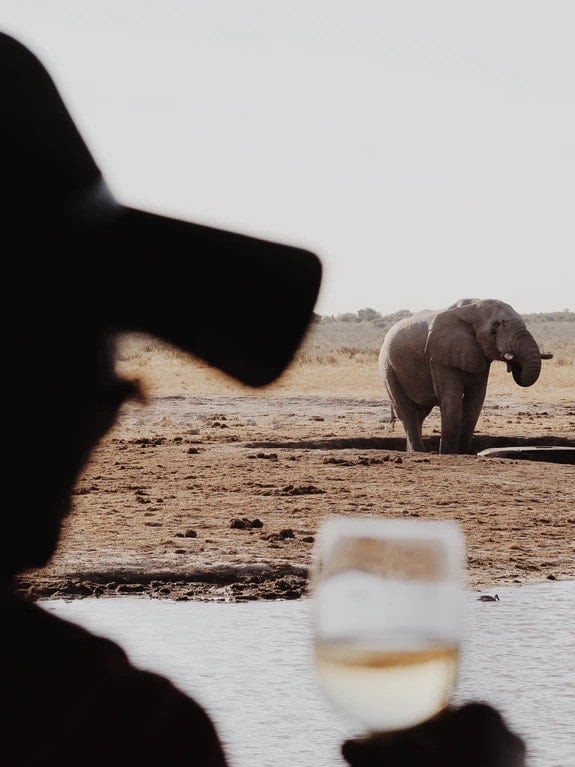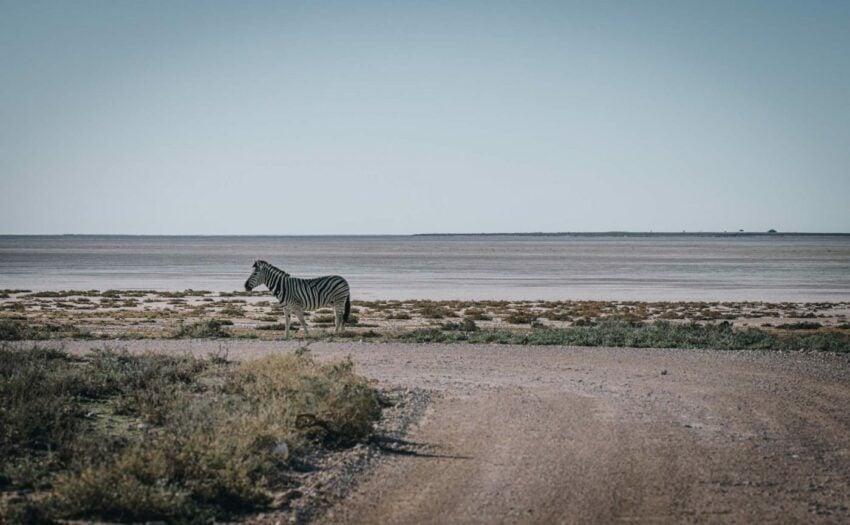It is no secret that Etosha is one of the most famous destinations in Namibia when it comes to safaris. Avid travellers and wildlife-lovers know that getting out of your car in Etosha National Park is against the rules and regulations of the park. Visitors not abiding by these rules are bound to face serious consequences. The Etosha lookout point, clearly indicated on the map available at kiosks within the park and at certain lodges outside the park, is one of the few places where you can jump out and take pictures.
When standing in the massive salt pan, you can see for miles. My travel partner and I, like many other travellers, got out to take some pictures here. Before taking the first picture, he asked, “What do you want me to take a picture of?” I looked around me and replied, “Of everything… or nothing, because that sums up all this space around us.” I even attempted a wheel pose, knowing that if anything came running towards us, we would spot it. This, of course, is highly unlikely. Even though animals abound all around the pan, they hardly venture into this area.
Put your knowledge to the test. How many of the facts below did you know before?
- Etosha once was a gigantic freshwater lake
Once a mighty freshwater lake, Etosha only became a salt pan when the Kunene River changed its course millions of years ago. Due to the clay soils in the region, the water could not seep into the ground, and as the surface was as flat as it is today, the flow of the water into other channels was extremely slow. The freshwater basins baked in the sun which caused progressive evaporation and led to salt formation. The biggest one of these basins is Etosha Pan at a staggering 5000 square kilometres, which is visible from space!
- Etosha still receives freshwater from time to time
Etosha’s clay soils are the lowland drainage point of the Cuvelai Basin, a trans-boundary wetland between Angola and Namibia known for its iishana, or also the “rivers” of the Cuvelai. Unlike most other wetlands, the Cuvelai has no outlet to the sea. None of the drainage channels ever reach the sea, but end in lakes and the above-mentioned pans. This means that when great rains soothe the parched earth, some of the waters fill up the iishana – the life-giving veins that enable locals in Owambo to practise agriculture. Some of the water might continue to the Etosha Pan. However, since the land surface here is extremely flat, the water moves very slowly. History repeats itself when fresh water turns salty once more.
 Rivers in the Cuvelai Basin, also sometimes referred to as the Etosha Basin, are called iishana. © Ron Swilling
Rivers in the Cuvelai Basin, also sometimes referred to as the Etosha Basin, are called iishana. © Ron Swilling
- The Etosha Basin used to be covered in sand dunes in drier times
In complete contradiction to the above-mentioned situation, conditions were so dry during other periods that wind-blown sand dunes covered the Basin. All flows of water were cut off during these times. It is said that the Basin possibly resembled the present southern Kalahari semi-desert covered in sand dunes. Today it is unthinkable to go to Etosha and stumble upon a red sand dune you would see when visiting the Kalahari in the south.
 It is even harder to imagine that Etosha resembled the Kalahari during drier times. © Gondwana Collection Namibia
It is even harder to imagine that Etosha resembled the Kalahari during drier times. © Gondwana Collection Namibia
Only when I was standing in the salt pan did the reality kick in of how vast it truly is. These wide open spaces have become a huge tourism attraction, be it the white plains in and around Etosha, the red dunes of the Kalahari, some of the world’s highest sand dunes in the Namib, or any other destination in this country that still boasts pristine landscapes. There are very few soul-cleansing experiences left in the world – Namibia is one of them. Gondwana Collection Namibia offers accommodation in all the most sought-after locations. Click on this link for all the options at your fingertips. Happy soul-cleansing discovery!
What is your favourite part about visiting Etosha?
Source: A profile and atlas of the Cuvelai-Etosha Basin by John Mendelsohn, Alice Jarvis, Tony Robertson; published by RAISON & Gondwana Collection
Author – Annelien Robberts is an avid wordsmith who turns her pen to all things travel, culture, and lifestyle. She was born in a small town called Otjiwarongo and grew up on a farm nearby. Creativity, nature and animals make her happy.






SUBMIT YOUR COMMENT